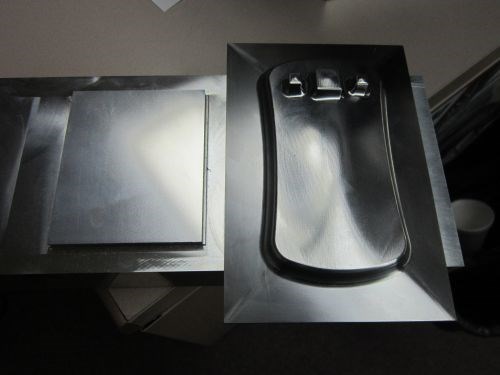Rethinking Three-Axis Capabilities
Ballnose cutters don’t necessarily require five-axis machining routines to impart fine surface finishes that don’t require hand polishing.

A three-axis machine and ballnose cutter proved sufficient to achieve this part's 16-µm surface finish without hand polishing.
Moldmakers could be missing out on substantial time and cost savings by underestimating the capabilities of their three-axis machine tools. So says Jim Endsley, machining center product specialist at Okuma America Corporation. During a recent open house event at the company’s Charlotte, North Carolina Headquarters and nearby Partners in THINC facility, he used the 4140, pre-heat-treated steel die shown above to demonstrate the possibilities of cutting “straight down” with a ballnose end mill rather than at an angle.
Some machinists might conclude that the only way to produce the part’s 16-µm surface finish without costly, time-consuming hand polishing would be to use an additional axis of motion to approach the work at an angle of about 15 degrees. This ensures clean cutting action by preventing the ballnose tool’s rounded bottom from rubbing the material. However, Endsley says machine and cutting tool technology has advanced to the point that this might not be necessary. Specifically, he cites flank design enhancements and tool coatings that enable newer ballnose tools to perform effectively at the high cutting parameters typical of modern machine tool CNCs. Along with the draft angles typical to mold and die components, these features enable users to achieve the same results in only three axes by approaching straight-on, but at significantly higher feed rates and reduced stepovers.
“The trend in moldmaking is always to overcomplicate things,” Endsley notes. That’s worth considering next time you’re considering the need for hand polishing or tying up a valuable five-axis machine with work that might not actually require either. Meanwhile, take a look at this slideshow for more of what I saw at the open house, including various “smart” technology that makes machining easier and more efficient, performs tedious tasks automatically and behind the scenes, and customizes how users interact with their equipment, among other systems.
Related Content
-
How to Produce More Accurate Molds and Reduce Rework
Patented micro-milling process for manufacturing steel plate flat and parallel helps mold builders shorten mold build times and increase accuracy.
-
Moldmakers Deserve a Total Production Solution
Stability, spindle speed and software are essential consideration for your moldmaking machine tool.
-
Leading Mold Manufacturers Share Best Practices for Improving Efficiency
Precise Tooling Solutions, X-Cell Tool and Mold, M&M Tool and Mold, Ameritech Die & Mold, and Cavalier Tool & Manufacturing, sit down for a fast-paced Q&A focused on strategies for improving efficiencies across their operations.







.png;maxWidth=300;quality=90)





